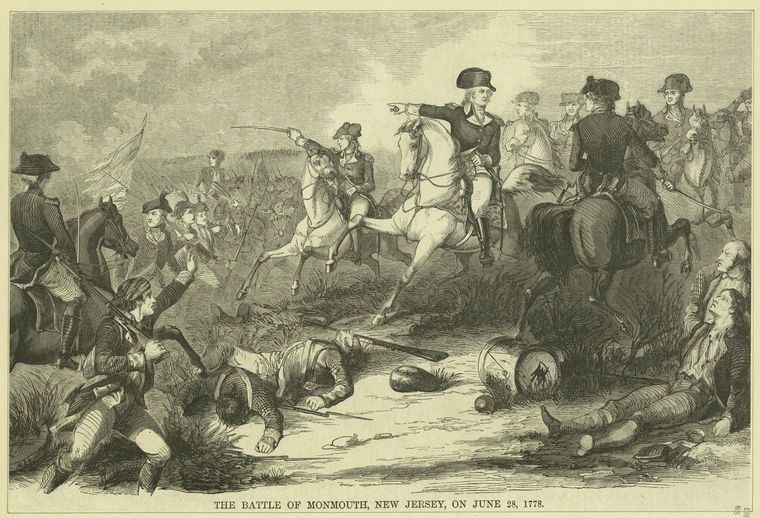On June 28, 1778, an indecisive engagement ensued between the American forces under General George Washington, and the British army under General Sir Henry Clinton. This battle could have been a “disastrous defeat” if General George Washington did not take control of the army and rally the American troops to continue fighting for their nation.[1] The fact that this was an indecisive engagement was really a victory for the American forces, because of the poor leadership by American General Charles Lee, who was put to trial and found guilty. This illustration of the Battle of Monmouth portrays the American forces riding in on horseback, with General George Washington giving orders to his army and rallying his troops to keep on fighting. It is unknown who originally was responsible for this illustration, and it was created sometime after the battle, to the year 1890. As one can infer from the illustration, the American forces are on the white horses, to symbolize the life and strength of the American army, while the British forces are on the black horses, which may symbolize death. Also, these opposing colors were chosen for the horses of each army to demonstrate how the armies fought on opposite sides of the war.
The British forces were very strong, as about seventeen thousand British soldiers marched through New Jersey, destroying many residences[2], with the goal of reaching New York from Philadelphia to continue negotiations regarding the war.[3] On the other hand, the American forces were becoming stronger and more confident, although they did not have the numbers that the British army had, they were in good spirits. The weather was forgiving, and they had recently received some reinforcements from the New England area, and a small army from New Jersey was ordered to make the British journey difficult by burning the bridges and just harassing them.[4] Once Washington heard that the British had left Philadelphia, he and about thirteen thousand men embarked on the journey to occupy the city. Here, Washington was joined by General Lee, who was just exchanged as a prisoner of war, but did not have the trust of General Washington.[5] The British army began to struggle, as it was continually harassed by the American forces, the heat began to take a toll on them, and the mosquitos made everything for them much harder. Once Washington discovered that the struggling British army had arrived at the Monmouth court house, he sent a small army led by General Lafayette to attack, as he promised to follow with support.[6] General Lee also decided to go against Washington’s orders, and decided to attack General Cornwallis’ army, which led to Lee losing and was forced to retreat. Once Washington heard about this, he was very unhappy with General Lee, and rushed over to try and fix everything. After punishing Lee for going against him, Washington took the retreating American troops, rallied them, and charged back at the British forces. They fought in hand to hand combat until nightfall, which brought an end to the battle with both sides still remaining.[7] However, overnight, the British army, including General Clinton, retreated, to Washington’s surprise. [8]The American forces also decided to retire to the Hudson River and not pursue the British. After the battle, Washington claimed that he buried 249 British soldiers on that field. General Lee’s actions ended up having him put to trial, where he was found guilty and was suspended of his duties for a year.[9] Without the genius strategies and motivation from General George Washington, this battle could have looked a lot different for both sides.
Although it is looked at as a small battle, a lot of lives have been affected by this, both at the time of the battle and the years following. The battle took place in a town where people resided, so the civilians were in danger. Albert Vander Veer tells a story from his grandmother, whose father’s house was used as a shelter from the violence for the women and children of the neighborhood. She also would carry water to the wounded soldiers during the battle because she remembers that it was very hot.[10] Many people in Monmouth suffered as a result of the Revolutionary War, as it was reported that almost 20% of the male population in Monmouth suffered as a result of the war, and this number is realistically probably higher because of all the unreported crime and suffering due to the Loyalists in Monmouth, as Monmouth had a very high percentage of Loyalists within it.[11]
[1] Dalton, J. C. 1927. “A Review and Historical Retrospect.” Edited by William S. Stryker and William Starr Myers. Journal of the Society for Army Historical Research 6 (26): 193–97.
[2] Vander Veer, Albert. 1928. “Three Generations from the Battle of Monmouth, June 28, 1778, to June 28, 1928.” The Quarterly Journal of the New York State Historical Association 9 (3): 280–84.
[3] Dalton, J. C. 1927. “A Review and Historical Retrospect.” Edited by William S. Stryker and William Starr Myers. Journal of the Society for Army Historical Research 6 (26): 193–97.
[4] Ibid.
[5] Ibid.
[6] Ibid.
[7] Ibid.
[8] Vander Veer, Albert. 1928. “Three Generations from the Battle of Monmouth, June 28, 1778, to June 28, 1928.” The Quarterly Journal of the New York State Historical Association 9 (3): 280–84.
[9] Dalton, J. C. 1927. “A Review and Historical Retrospect.” Edited by William S. Stryker and William Starr Myers. Journal of the Society for Army Historical Research 6 (26): 193–97.
[10] Vander Veer, Albert. 1928. “Three Generations from the Battle of Monmouth, June 28, 1778, to June 28, 1928.” The Quarterly Journal of the New York State Historical Association 9 (3): 280–84.
[11] Adelberg, Michael S. 2009. “An Evenly Balanced County: The Scope and Severity of Civil Warfare in Revolutionary Monmouth County, New Jersey.” The Journal of Military History 73 (1): 9–47.
